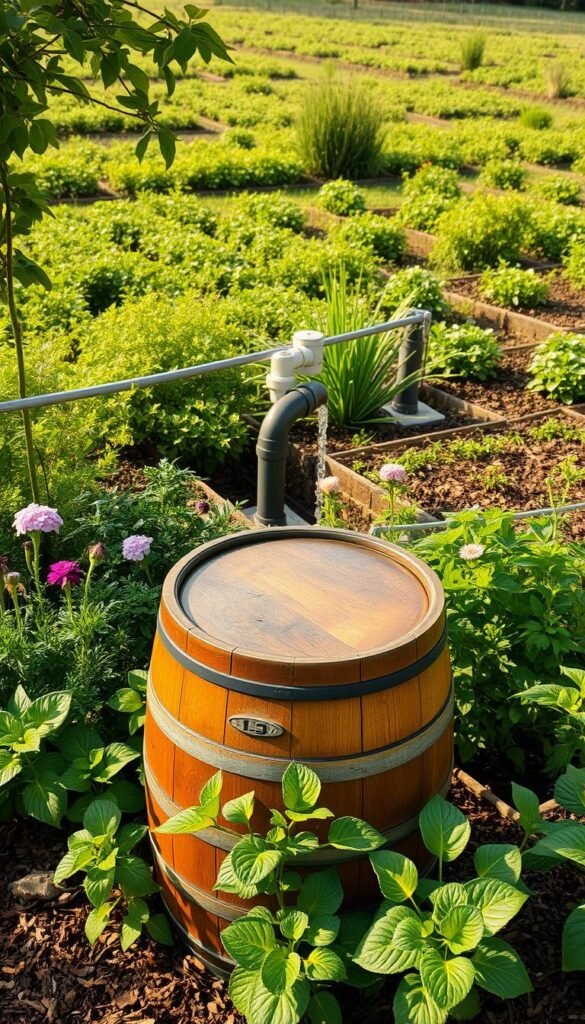Imagine cutting your utility bills while protecting the planet—all by making small, intentional changes at home. With unpredictable weather and rising costs, managing your household’s usage of essential resources isn’t just smart—it’s critical for a sustainable future.
This guide walks you through practical steps to reduce waste in every corner of your life. From gardens to kitchens, you’ll learn how efficient devices and mindful habits work together to preserve what matters most. Even small shifts, like using container gardens with self-watering systems, can save up to 50% of what you’d normally use outdoors.
Why does this matter? Every drop saved today supports healthier ecosystems and stronger communities tomorrow. Plus, you’ll see the difference in your monthly expenses—proving that doing good for the Earth also benefits your wallet.
Ready to start? Let’s explore how blending simple daily choices with modern innovations creates lasting change. Whether you’re upgrading appliances or rethinking routines, your efforts add up to something bigger than just savings.
Introducing Your Water Conservation Journey
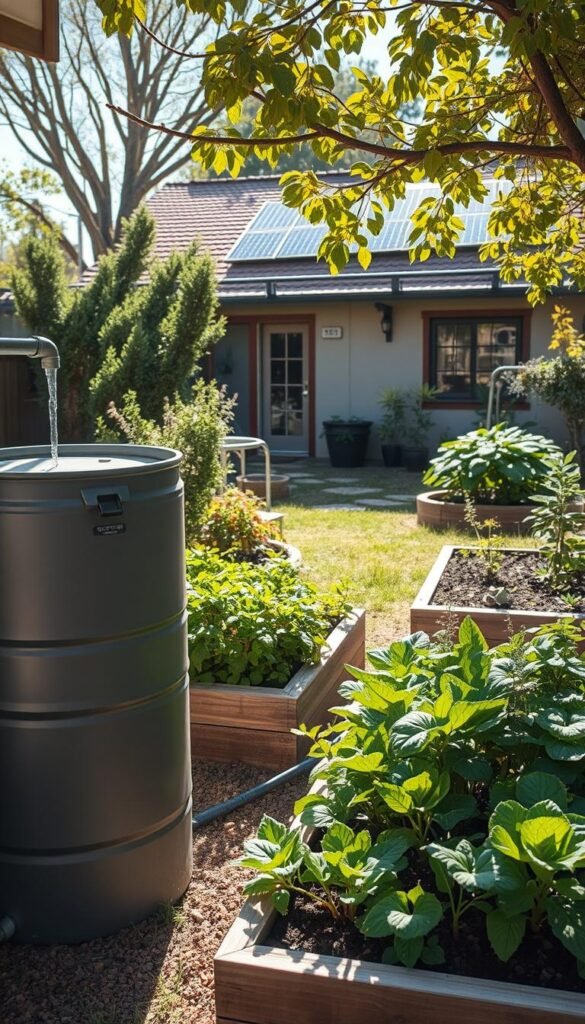
Your journey toward a greener lifestyle begins with simple, impactful changes in daily habits. These steps not only lower bills but also protect ecosystems for future generations. Think of your home as a living lab where every choice matters.
What It Means for Your Household
Reducing usage isn’t just about shorter showers. It’s a mindset shift toward valuing resources in kitchens, gardens, and beyond. For example, pairing sustainable gardening methods with efficient fixtures creates a ripple effect. Your efforts inspire neighbors while easing strain on local supplies.
Building Habits That Last
Start by auditing where waste happens—like leaky faucets or overwatered plants. Fixing these spots offers quick wins. Over time, these habits grow into second nature, proving that sustainability fits seamlessly into modern life.
Your actions today set the stage for healthier communities tomorrow. Plus, watching your savings grow makes every effort worthwhile!
Water Conservation: Rain Barrels, Greywater, and Mulch Techniques
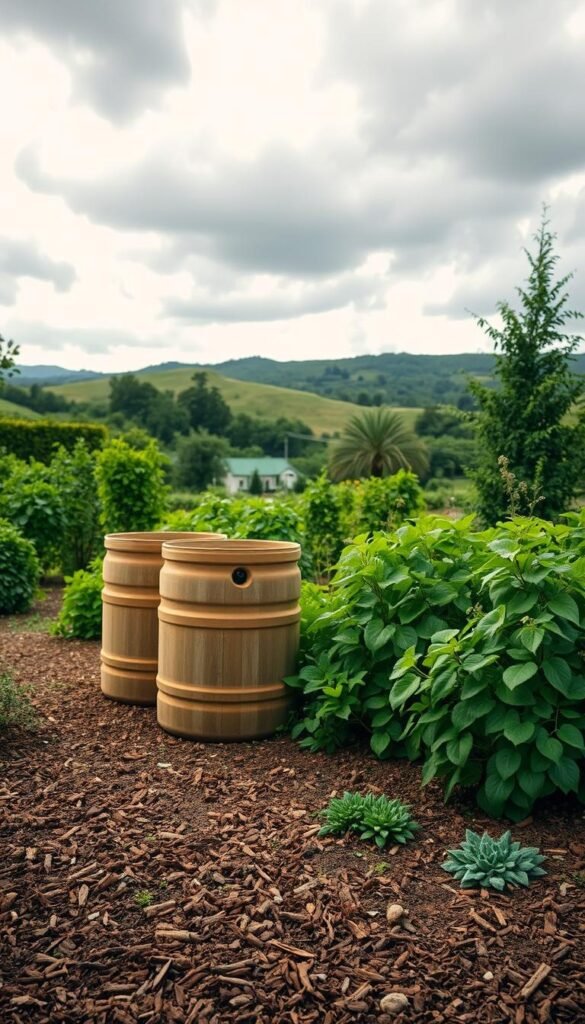
Efficiency isn’t just about saving—it’s about smartly reusing what you already have. Three core strategies form the backbone of this approach: harvesting rainwater, repurposing gently used household liquids, and protecting soil moisture. Together, they create a resilient system that keeps your outdoor spaces thriving while easing demand on public supplies.
Understanding the Core Concepts
Rain barrels act as nature’s free delivery service, capturing runoff from rooftops during storms. “One inch of rain on a 1,000-square-foot roof yields over 600 gallons,” explains a landscape expert. This stored resource becomes your garden’s backup plan during dry spells.
Greywater systems give a second life to liquid from showers or laundry. With proper filtration, these gentle soaps won’t harm plants—they’ll nourish them. Pair this with smart watering techniques to stretch every drop further.
Organic mulch acts like a sponge blanket for soil. A 3-inch layer can cut evaporation by up to 70%, meaning you’ll refill those watering cans less often. Over time, decomposed materials also feed earthworms and microbes, creating richer earth that holds moisture naturally.
When combined, these methods form a self-reinforcing loop. Collected rain feeds plants, which then filter greywater through their roots. Mulch keeps both systems hydrated longer, reducing how often you need to intervene. It’s how farms survive droughts—and how your yard can too.
Harvesting Rainwater: Embracing Rain Barrels and Cisterns
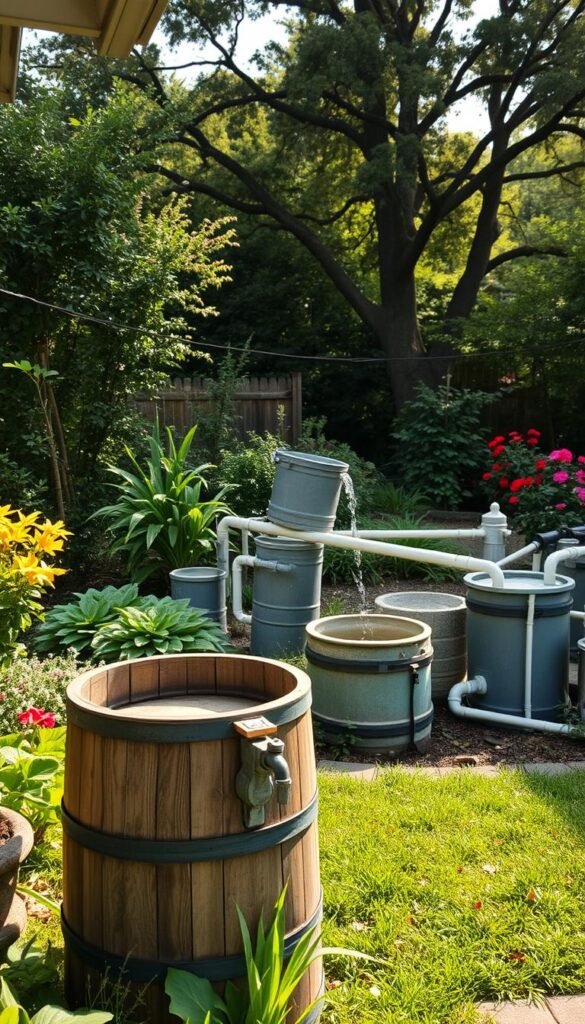
Your roof isn’t just shelter—it’s a rainwater goldmine waiting to be tapped. By channeling storm runoff into storage systems, you’ll create a backup supply for gardens while easing pressure on municipal sources. Let’s explore how to set up and maintain these eco-friendly solutions.
Installation and Maintenance Tips
Begin with 50-100 gallon containers placed beneath downspouts. These catch roof runoff efficiently during storms. For larger needs, underground cisterns store 1,000+ gallons—ideal for extended dry spells.
Keep your system flowing smoothly:
- Flush collection lines monthly to prevent sediment buildup
- Inspect gutters weekly for leaves or blockages
- Clean storage containers seasonally with vinegar solutions
Add mesh filters and leaf guards to protect stored supplies. “Debris-free systems last longer and deliver cleaner liquid for plants,” notes a sustainable landscaping expert.
Maximizing Rainwater Collection Efficiency
Metal roofs yield the purest runoff, while asphalt shingles may need charcoal filters. Connect multiple barrels with overflow pipes to expand capacity without complex plumbing.
Your roof’s size dictates potential. A 1,500-square-foot surface collects over 900 gallons from just 1 inch of rain! Pair this with drip irrigation to stretch every drop further.
Unlocking the Power of Greywater at Home
Your home produces hidden resources daily—like gently used liquid from showers, sinks, and laundry. Instead of sending it down drains, this gently used supply becomes a lifeline for gardens when managed thoughtfully.
How to Safely Recycle Greywater
Start with diverter valves on bathroom and kitchen drains. These redirect flow into storage containers without complex plumbing. Choose plant-based soaps free of harsh chemicals—they nourish soil instead of harming microbes.
Focus irrigation on ornamental shrubs or fruit trees. Avoid spraying edible greens directly. Buried perforated pipes distribute moisture evenly while preventing contact with humans or pets. Rotate zones weekly to let soil process residues naturally.
Simple Methods for Kitchen and Bath Reuse
Collect sink runoff in buckets for outdoor palms or berry bushes. Shower water? Attach a hose to drain pipes for gravity-fed watering. “Families cut their use by half just by repurposing bathwater for landscape needs,” shares a permaculture designer.
Upgrade washing machines with dual-output systems. One line handles dirty discharge, while the other sends lightly soapy liquid to storage tanks. These tweaks let you nourish plants while using less water overall.
Mastering Mulch Techniques for Water Retention
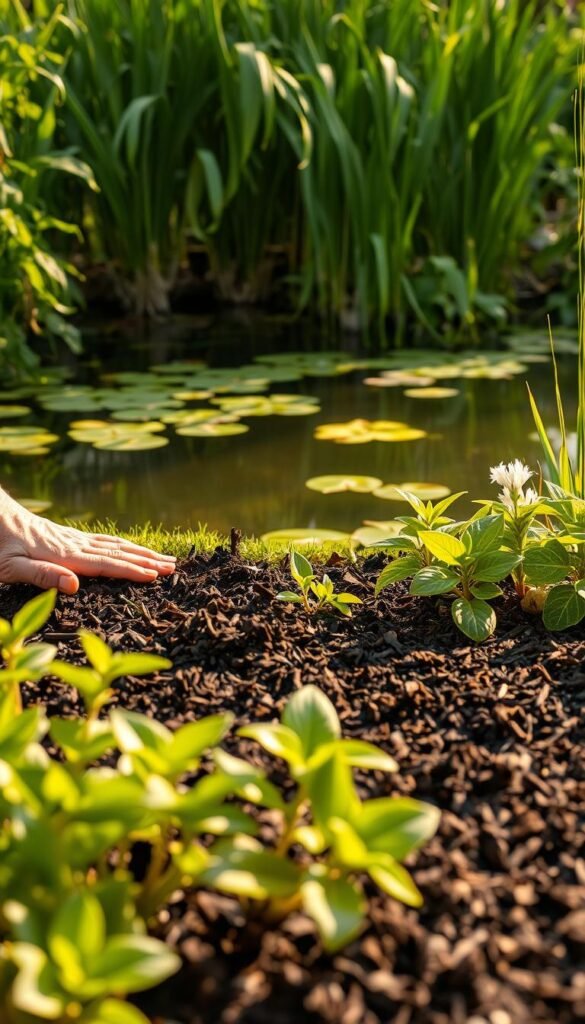
Your garden’s secret weapon lies right under your feet. A well-designed mulch layer acts like a protective shield, locking in precious moisture and creating ideal growing conditions. Let’s explore how choosing the right materials and application methods transforms your landscape into a drought-resistant oasis.
Selecting the Best Mulch Materials
Shredded wood and straw top the list for durability and breathability. Fallen leaves work wonders too—especially when decomposed into leaf mold. “This material can hold five times its weight in moisture,” notes a soil scientist. Aged compost adds nutrients while improving texture, making it perfect for vegetable beds.
Application Strategies for Maximum Moisture
Spread materials 2-4 inches thick around plants, keeping a 3-inch gap near stems. This prevents rot while letting roots breathe. In summer’s heat, push layers to 6 inches for extra evaporation protection. Refresh annually as organic matter breaks down, feeding earthworms and boosting soil health.
You’ll notice changes quickly. Gardens need watering less often, and weeds struggle to penetrate nature’s blanket. Over time, decomposed mulch becomes rich humus—improving both moisture retention and soil structure. It’s like giving your plants a slow-release drink that also builds healthier earth!
Enhancing Your Garden with Native Plants and Soil Moisture Management

Local flora holds the key to creating resilient, water-wise landscapes. Species naturally adapted to your region’s climate require less pampering while supporting pollinators and soil health. These green allies work smarter—not harder—to maintain vibrant outdoor spaces.
Choosing Plants for Low Water Needs
Focus on species that evolved in your area. “Native roots grow deeper, tapping into underground reserves during dry spells,” says a Midwest horticulturist. During their first year, give them weekly hydration to establish strong foundations. After that, they’ll thrive on rainfall alone in most seasons.
| Plant Type | Examples | Water Needs After Year 1 | Benefits |
|---|---|---|---|
| Trees | Oak, Redbud | Rarely | Shade & erosion control |
| Shrubs | Manzanita, Sage | Minimal | Wildlife habitat |
| Flowers | Coneflower, Lupine | Occasional | Seasonal color |
Perennial blooms like black-eyed Susans outlast thirsty annuals while needing 60% less attention. Match species to your garden’s sunlight and soil type—drought-tolerant sedum thrives in rocky spots, while swamp milkweed loves damp corners.
Your choices create ripple effects. Deep-rooted plants stabilize soil, reduce runoff, and feed beneficial insects. Over time, you’ll spend less time watering and more enjoying nature’s self-sustaining show.
Reducing Indoor Water Consumption: Kitchens, Bathrooms, and Laundry
Your home’s hidden savings potential isn’t just in the yard—it’s flowing through every faucet and pipe. Simple upgrades and mindful routines can slash your water usage while keeping daily life comfortable. Let’s dive into how modern tools and clever habits work together to reduce water waste where it matters most.
Water-Saving Appliances and Fixtures
Upgrading devices makes a huge difference. Modern dishwashers use less water than hand-washing—especially when you wait for full loads. Swap old showerheads for low-flow models that still deliver strong pressure at 2 gallons per minute. Dual-flush toilets let you choose between liquid and solid waste settings, cutting bathroom water use by up to 20% annually.
High-efficiency washers are game-changers. They tumble clothes instead of soaking them, using 34-80% less water per cycle. Pair these with cold washes to shrink your water bill and energy costs simultaneously.
Small Changes for Big Savings
Quick adjustments compound over time. Fill sink basins for dishwashing instead of letting taps run. Fix leaky faucets promptly—a drip per second wastes 3,000 gallons yearly. Shorten showers by two minutes to save water without sacrificing comfort.
Track your water usage monthly. Notice spikes? Adjust habits like lawn watering or laundry frequency. These tweaks help you reduce water waste while keeping your water bill predictable. Remember: every drop saved indoors supports healthier ecosystems outdoors!

